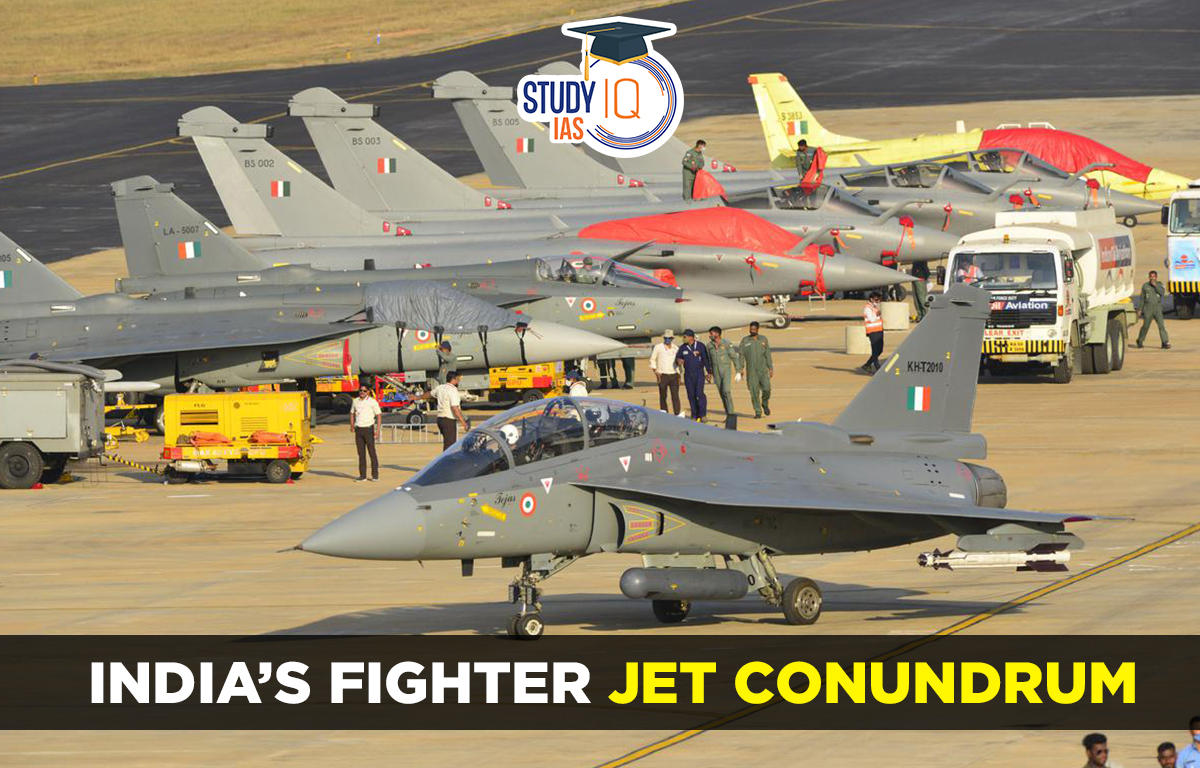Table of Contents
Context: As per the recent statement of the Indian Air Force (IAF) to parliamentary standing committee on defence, India’s fighter jet squadron strength will dip to dangerously low levels by 2030 unless steps are taken to acquire new aircrafts.
Decoding the News
- The Air Force has not specified when the maximum squadron strength of 42 can be achieved. However, it has assured that the squadron strength will be between 29 to 31 squadrons by 2030 if 114 Multi-Role Fighter Aircraft (MRFA) order will be delivered.
- The effort to ensure squadron strength does not fall below 29 rests on the 83 Light Combat Aircraft (LCA) — MK1A, LCA-MK2 and MRFA.
Current Squadron strength of Indian Air Force
- Current: Current strength of squadrons is 31, out of which three Mig-21 squadrons will be phased out by 2025. In addition, Jaguars, Mirage-2000s and Mig-29s will be phased out by 2030.
- By early 2040s, most of the MIG-29s will be phased out. Some of the earlier batch of SU-30s will also start retiring.
- New additions: A deal to buy 12 additional SU-30MKIs to replace lost ones as well 21 additional MIG-29s from Russia has been stuck, even though the deal is not dead.
- India has plans to acquire over 500 fighter jets in the coming years, with majority of them to be indigenously designed and manufactured, to be used by IAF. However, timely deliveries are critical.
| LCA Programme | The Light Combat Aircraft (LCA) was an indigenous jet development programme, originally intended to replace MiG-21. After a series of delays, LCA obtained Final Operational Clearance (FOC) in February 2019.
IAF had signed a contract with Hindustan Aeronautics Limited (HAL), for 20 IOC configuration aircraft including four IOC trainers and for 20 FOC configuration jets. They are currently being delivered. |
| LCA MK1A | Ministry of Defence had signed Rs 48,000 crore deal with HAL for 83 LCA-MK1A. HAL will be delivering the first three aircraft in 2024 and 16 aircraft per year subsequently in the next five years. |
| LCA-MK2 | The advanced version has received approval from the Cabinet Committee on Security (CCS) for a total cost of Rs 9000 crore. It will start production from 2027.
The LCA-MK2 will be similar to the Mirage-2000. |
| AMCA | The fifth generation Advanced Medium Combat Aircraft (AMCA) is awaiting approval, and the development of it would take 10 years more. The cost is expected to be around Rs 15,000 crore. |
Light Combat Aircraft (LCA) Programme
- Light Combat Aircraft (LCA) has been named Tejas. Tejas is a single-engine and highly agile multi-role supersonic fighter aircraft manufactured by Hindustan Aeronautics Limited (HAL).
- Versions of Tejas LCA:
- Tejas Mk-I: The Mk-I version is made up of 60% indigenous content. It is a fourth-generation aircraft.
- Tejas Mk-IA: It is equipped with Active Electronically Scanned Array (AESA) Radar, Advanced Short-Range Air-Air Missile (ASRAAM), Electronic Warfare (EW) Suite and Air to Air Refueling (AAR).
- AESA can track multiple enemy targets with high accuracy and EW identifies and locates threat signals, attack or jam adversary’s signal operations.
- Tejas Mk-2: This version has increased payload carrying capacity and internal fuel capacity, redesigned cockpit, improved combat range, and an integrated infrared search and track (IRST) system.
- Tejas Naval variant: The naval variant will be lighter than it normal version to ensure easy take-off and landing from Aircraft carriers.
Impact of Dwindling number of fighter jets on India’s Security
- Decline in combat air patrol: With limited number of fighter jets having capability to be operational, the combat air patrol of the force is likely to decline.
- The IAF’s footprint across India’s forward territories is also likely to decrease significantly.
- Capability to engage in two-front war: The threat of a two-front war looms large due to increasing collaboration between China and Pakistan.
- Without the sanctioned strength of 42 squadrons, IAF will face an uphill task of successfully tackling challenges.
Challenges for Increasing Fighter Jets
- Delay in production: Indigenous aircraft production has been delayed due to various challenges, most of them related to development of critical technologies. Most critical technologies have to be developed from scratch, leading to unplanned delays.
- The Ukraine war: The Ukraine war had delayed orders for Indian Air force, including fighter jets and their critical components.
- Sanctions on Russia have affected payments to be made by India, leading to further delay of orders.
- Budgetary challenges: Acquisition or indigenous production of fighter aircrafts needs huge budgetary outlays. This discourages governments from undertaking regular acquisition.
- Perception of corruption: There is always accusation of corruption whenever a large defence order is placed. Governments are reluctant to get embroiled in such controversies and thus avoid regular acquisitions.
Way Forward
- Prospects: Looking at the current rate of acquisition of LCA Mk1A, the IAF needs to maintain strength of 29-31 squadrons. The numbers must not fall below this.
- LCA Mk1A will help increase squadron strength, but they will not be joining in sufficient numbers anytime soon.
- Foreign-domestic partnership: IAF has emphasized the need to develop medium role fighter aircraft that will also be made in India as part of the push for self-reliance.
- Under the model, planes would be manufactured in India with partnership of a foreign equipment manufacturer. Dassault, the manufacturer of Rafale, is the leading contender for this requirement.
- Augment fleet strength: It is necessary to augment the fleet strength of fighter aircrafts so that it can operate over a larger region and handle adverse challenges.
- Increase serviceability: Life of existing aircrafts such as Su-30MKI can be extended by carrying out support agreements as well as joint ventures in India with Russian original equipment manufacturers for faster turnaround.





















 WhatsApp
WhatsApp